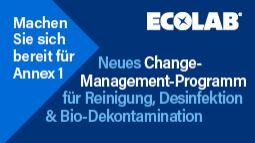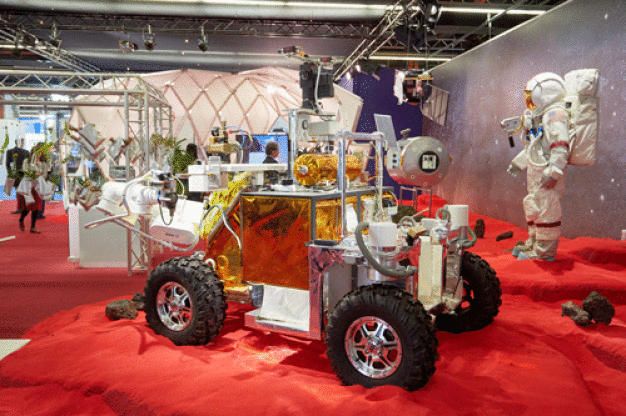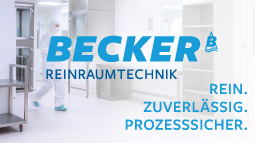- Trade fair
Cleanzone 2017 provides information on cleanrooms for modern optics
Autonomous driving or space exploration: Optical systems place tremendous demands on cleanrooms
Key drivers of change in our mobile lives come from the digital world and its imaging and image processing technologies. Be it autonomous driving, package delivery by drones or space exploration, a key requirement for future developments in these fields is high-resolution optical systems – and the necessary precision can only be provided when production takes place in cleanrooms. Manufacturers will be showing how to configure cleanrooms to satisfy the requirements of modern optics at the Cleanzone cleanroom trade fair on Tuesday and Wednesday, 17/18 October 2017, in Frankfurt am Main.
The aforementioned examples represent the fulfilment of long-standing dreams: cars will be rendered safer and more comfortable in a revolutionary way. Yet in order to mimic and exceed the performance of the human eye, it is necessary to have optics with a heretofore unheard of sensitivity and sharpness of detail – and this means that even the tiniest impurities can cause problems for the systems. This is already necessary for significant and everyday, and therefore presumably simpler, tasks such as in road traffic. The large number of moving objects results in a complexity that cannot be processed without precision optics. Another example is offered by the “European Extremely Large Telescope” (E-ELT) in Chile. One primary mirror and two corrective mirrors, not to mention the need to compensate for distortions that result when light from space passes through the Earth’s atmosphere by minimally bending the mirror surface – adjustments in the magnitude of a few ten-thousandths of a millimetre.
Challenge for the future: 7-nanometre technology
Holistic concepts are also growing in importance. Whereas optics were designed and produced separately in the past, today manufacturers must also solve the follow up-problem: each individual piece of optics has specific faults. For example, the individual rays comprising a beam may not converge on a single point after traversing an optical system, resulting in an aberration; other faults including various types of distortions and chromatic aberrations. Strictly speaking, the perfect depiction of an expansive object is only possible with flat mirrors (James Clerk Maxwell, 1858; Constantin Carathéodory, 1926). Taking into account the subsequently utilised hardware, it is now necessary to develop software that is suitable for compensating for these faults – – and the overall system cannot be allowed to grow too large, because even a car has but limited space for electronics and optics.
There is one thing that is of the utmost importance for optics: both during the production of lenses and in the subsequent steps, painstaking care must be taken to avoid impurities. This includes the bonding of multiple lenses or of lenses and sensors, for example. In chip production, these requirements quickly render the latest 7-nanometre technology a necessity. It is a type of lithography, with the special distinction that wavelengths in the extreme ultraviolet spectral range are used, and the structures are created in a vacuum. Here, production may take place in cleanroom class 1 mini-environments of just eight cubic metres in size, for example. A seven-nanometre structure is equivalent to five carbon atoms in a row. For cleanroom technology, this means that impurities as small as a single molecule can be a concern. This includes not only airborne molecular contamination (AMC), but also surface molecular contamination (SMC).
Impurities in cleanrooms
In optics and electronics, one example of something that can seriously disrupt the manufacturing process is ammonia, which can be introduced by personnel or result from solvents containing isopropyl alcohol. Bonding and furnace processes are very sensitive to outgassing substances such as chlorine and silicon tetrabromide (SiBr4). Other familiar “cleanroom impurities” include acetone (source: personnel), hydrogen bromide and hydrogen chloride, water and sulphuric acid (source: processes), the solvent PGMEA (propylene glycol methyl ether acetate), the silylation agent HMDS (bis(trimethylsilyl)amine) and TEOS (tetraethyl orthosilicate), a compound used in sol-gel processes.
Whereas these substances can be registered analytically, the monitoring of airborne hydrocarbons, epoxides and seemingly ubiquitous siloxanes are a focus of research in the fields of aerospace, microelectronics and optics.
New approaches for chemical-analytical monitoring systems
“Accurate measurement of these three types of substances – hydrocarbons, epoxides and siloxanes – has proven to be particularly difficult, and we still have not found a satisfactory solution,” says Markus Thamm, who is responsible for sales and marketing at cleanroom.de, Heidelberg. “Even so, there are a number of promising approaches that I believe might be ready for successful use sometime this year. For me, the key is to go beyond recording values at intervals, and to institute a system of continuous monitoring for these three types of substances.” important that quality controls are capable of detecting mechanical faults. Volker Knorz, KLA-Tencor, Weilburg: “To do this, we have to measure the surfaces of complex lens systems or wafers and be able to detect particles and scratches that are well under 100 nanometres in size. This is yet another prerequisite for optics that are suitable for use in autonomous vehicles or space exploration.”
A targeted tour of the Cleanzone trade fair in October 2017 will bring visitors up to date on the current state-of-the-art in cleanroom technology, something that is of vital importance for the booming optics industry. Perhaps some will even get a little bit closer to space travel during their trade fair visit.
![]()
cleanzone
Messe Frankfurt Exhibition GmbH
Ludwig-Erhard-Anlage 1
60327 Frankfurt am Main
Germany
Phone: +49 69 75756290
Fax: +49 69 757596290
email: anja.diete@messefrankfurt.com
Internet: https://cleanzone.messefrankfurt.com









